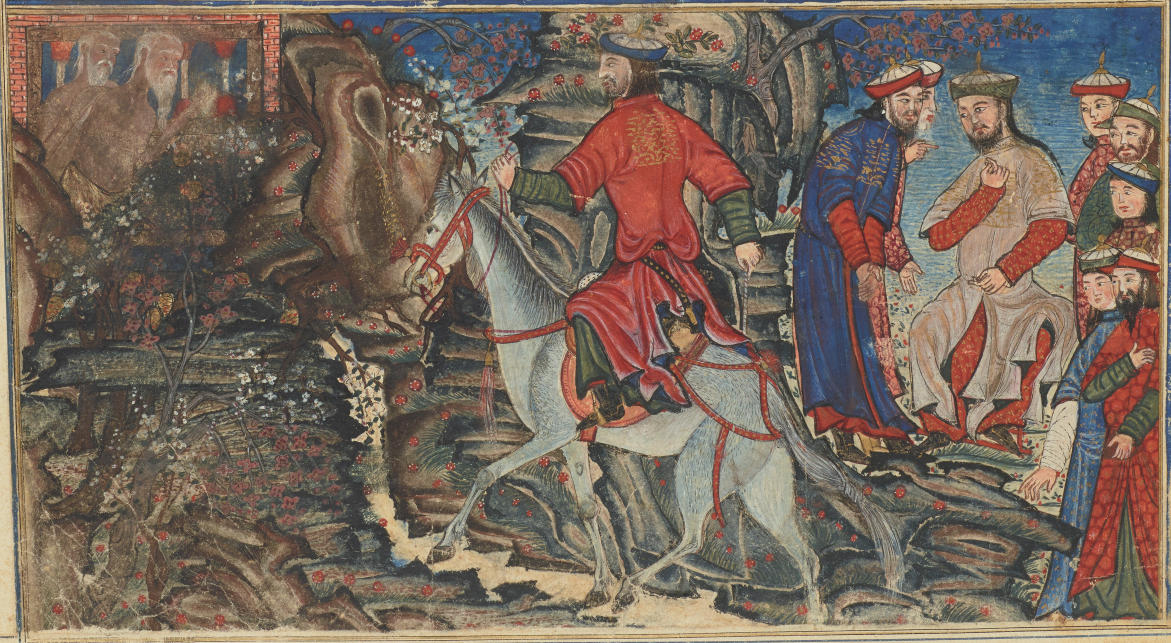Create an Amazon Business Account

Find the perfect fit with Amazon Prime. Try Before You Buy.
Ilkhanid Illustration
Great Mongol (Demotte) Shāh-Nāmeh
Chapter 20 - Iskandar (14 years)
Iskandar in the land of the Brahmins
Tabriz, Persia, c.1335AD

A larger image of 'Iskandar in the land of the Brahmins', Great Mongol (Demotte) Shāh-Nāmeh, Tabriz, c.1335 - Ilkhanid Soldiers. Sackler Gallery, S1986.105.
Folio from a Shahnama (Book of kings) by Firdawsi (d.1020); Recto: Taynush before Iskandar and the Visit to the Brahmans.; Verso: text
HISTORICAL PERIOD: Il-Khanid dynasty, ca. 1330-1340
MEDIUM: Opaque watercolor, ink and gold on paper
DIMENSIONS: H x W: 59.5 x 40.4 cm (23 7/16 x 15 7/8 in)
GEOGRAPHY: Iran, Tabriz
CREDIT LINE: Purchase ó Smithsonian Unrestricted Trust Funds, Smithsonian Collections Acquisition Program, and Dr. Arthur M. Sackler
COLLECTION: Henri Vever collection
ACCESSION NUMBER: S1986.105.1
PROVENANCE
To 1913: Georges Demotte (1877-1923), Paris, France. [1]
From 1913 to 1942: Henri Vever (1854-1942), Paris and Noyers, France, purchased from Georges Demotte, Paris, France on December 12, 1913. [2]
From 1942 to 1986: Family member, Paris and Boulogne, France, by inheritance from Henri Vever, Paris and Noyers, France. [3]
From 1986: Arthur M. Sackler Gallery, purchased from a family member, Paris and Boulogne, France. [4]
Notes:
[1] See Glen D. Lowry and Susan Nemazee, "Appendix 2: Ledger of Acquisitions, 1894 and 1907-17" in A Jewelerís Eye: Islamic Arts of the Book from the Vever Collection (Washington, D.C.: Arthur M. Sackler Gallery, Smithsonian Institution; Seattle and London: University of Washington Press, 1988), p. 235. See also Susan Nemazee, "Appendix 7: Chart of Recent Provenance" in An Annotated and Illustrated Checklist of the Vever Collection, Glenn D. Lowry et al (Washington, D.C.: Arthur M. Sackler Gallery, Smithsonian Institution; Seattle and London: University of Washington Press, 1988), p. 402.
[2] See note 1.
[3] See the Agreement for the Purchase and Sale of the Henri Vever Collection of January 9, 1986, Collections Management Office.
[4] See note 3.
Source: Sackler Gallery
Fig. 190 (cat. no. 50).
Taynush before Iskandar; The Visit to the Brahmans, from a page of the Great Mongol Shahnama (Book of Kings),
Iran (probably Tabriz), 1330s.
Ink, colors, and gold on paper.
Arthur M. Sackler Gallery, Smithsonian Institution, Washington, D. C.; Purchase, Smithsonian Unrestricted Trust Funds, Smithsonian Collections Acquisition Program, and Dr. Arthur M. Sackler
(S1986.105)
50 Fig. 190
Taynush before Iskandar and The Visit to the Brahmans
Image: 15.1 x 28.6 cm (6 x 11¼ in.)
Arthur M. Sackler Gallery, Smithsonian Institution, Washington, D.C.; Purchase, Smithsonian Unrestricted Trust Funds, Smithsonian Collections Acquisition Program, and Dr. Arthur M. Sackler
(S1986.105)
Moving westward from Hind, Iskandar went on a pilgrimage to Mecca and made his way to Andalusia in Spain, ruled by Queen Qaidafa.
The queen entered into a pact with Iskandar and was left unharmed.
Her son Taynush, however, who was the son-in-law of the slain Fur of Hind, was eager to seek retribution for Furís death.
Qaidafa had also received Iskandarís promise not to harm her son; yet wanting to test Taynush himself, Iskandar contrived an ambush and forced Taynush into a confrontation.
When assured of the princeís loyalty, Iskandar ordered a throne and banquet to be set up in the forest and celebrated with Taynush and his companions.
After leaving Andalusia, Iskandar proceeded to the country of the Brahmans in order to question them about the meaning of life and death.
The Brahmans, world-renouncing hermits and ascetics, lived in the forest.
They told Iskandar that greed and need were the two greatest evils in life, and that death was inevitable regardless of oneís worldly achievements.
The painting, which has no title or heading to identify the subject, appears to be a composite of the two narratives.1
In the right one-third of the image is the feast prepared for Iskandar, who is seated beneath the boughs of a tree as described in the text,
surrounded by Taynush and his companions.
The remaining pictorial space is devoted to Iskandarís visit to the Brahmans,
who are framed by a generic architectural setting in the upper left corner and can be recognized by their long beards and naked torsos.
1. Grabar and Blair 1980, pp. 120-21, no. 32; Lowry 1988, pp. 84-85, no. 11.
Source: pp. 163 & 256, The Legacy of Genghis Khan Courtly Art and Culture in Western Asia 1256-1353
Washington DC, Arthur M. Sackler Gallery
Title of Work: Shahnama (Great Mongol)
Manuscript: S1986.100-107
Accession Number: S86.0105
Chapter 20 - Iskandar (14 years)
Scene: Iskandar in the land of the Brahmins
Dimensions (h x w): 155 x 280 mm
Format: Rectangular within borders
Reconstructed Folio: 171r
Gregorian Date: 1335 (circa)
School: Tabriz
Source: Shahnama Project
Previous: f. 168r: 'Iskandar kills the Fur of Hind'. Great Mongol (Demotte) Shahnama. Tabriz, Persia. Ilkhanid Illustration. Keir Collection.
Next: f. 172r: 'Iskandar kills the Abyssinian monster'. Great Mongol (Demotte) Shahnama. Tabriz, Persia. Ilkhanid Illustration. Museum of Fine Arts, Boston, 30.105.
Back to the Great Mongol (Demotte) Shah-Nameh. Tabriz, Ilkhanid Persia.


